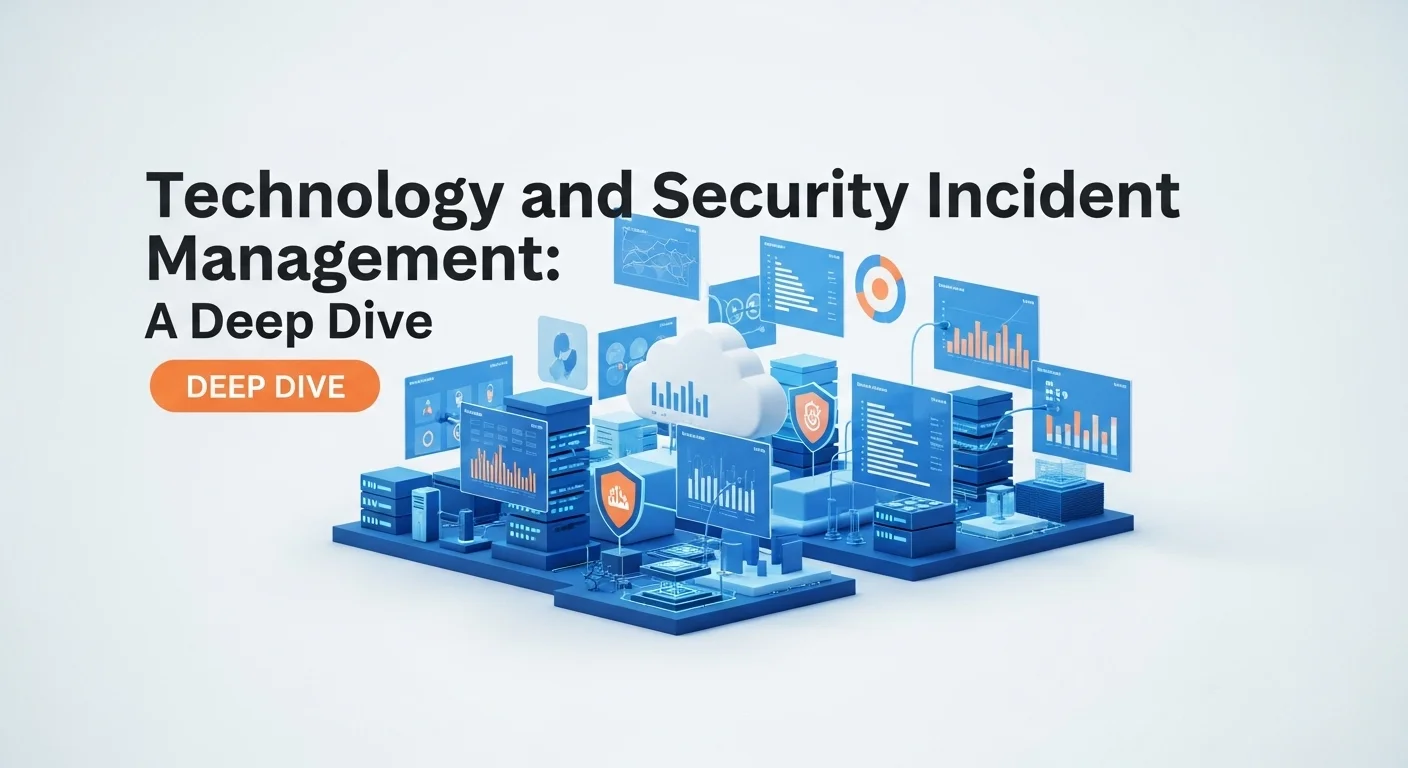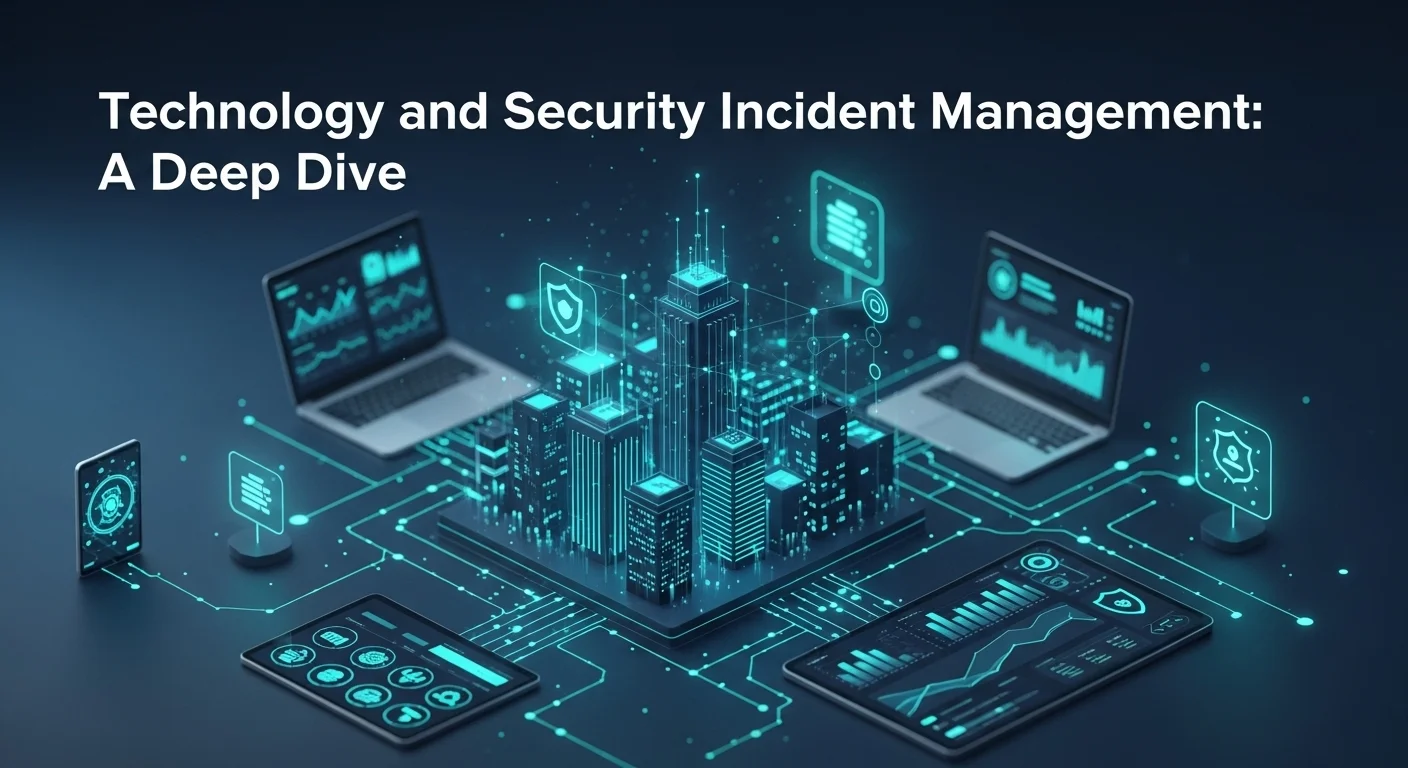From Crisis to Control: A Real-World Guide to Security Incident Management

Executive Summary
In my years in cybersecurity, I've learned one thing for certain: it's not a matter of *if* your organization will face a security incident, but *when*. That simple fact makes having a solid Security Incident Management plan one of the most important things you can do for your business. This isn't just about reacting to a problem; it's a structured way to prepare, detect, contain, and recover from any cyber threat. Think of it as your emergency response plan for the digital world. A good plan protects your critical assets, keeps the business running, minimizes financial hits, and, most importantly, maintains the trust you've built with your customers. This article is your guide. We'll break down the core ideas of incident management, look at how it applies in the real world, explore the tools you can use, and share best practices that will strengthen your defenses against the constantly changing threats out there.
Table of Contents
Table of Contents
- What is Security Incident Management and Why Does It Matter?
- The Modern Tech Challenge
- Real-World Business Benefits
- A Complete Guide to Your Incident Response Plan
- The 4 Phases of Incident Response (NIST Framework)
- Actionable Tips and Strategies to Improve Your Security
- Core Best Practices for a Resilient Program
- Advanced Strategies Using Modern Tools
What Exactly Is Security Incident Management, and Why Should You Care?
In a world where our businesses run on data and digital tools, the idea of Security Incident Management has moved from the IT server room to the executive boardroom. At its heart, it’s a formal process for handling security threats in real-time. It provides a clear, structured plan for your organization to respond to a cyberattack or data breach, with the goal of minimizing the damage and learning from the experience to prevent it from happening again. This process isn't just about technology; it's a coordinated effort involving your tech, your processes, and your people.
To really get it, you need to know the difference between a security 'event' and a security 'incident'. An 'event' is just something that happens on your network, like a user logging in. Thousands of these happen every day and are perfectly normal. An 'incident', however, is an event that actually breaks your security rules or poses a real threat. Knowing when a simple event becomes a full-blown incident is what kicks your response plan into gear. Trust me, making this distinction is crucial—it keeps your security team from chasing ghosts and lets them focus on the threats that truly matter.
The Technological Imperative in a Hyper-Connected Era
Today's technology is a web of interconnected systems. With cloud computing, the Internet of Things (IoT), AI, and so many people working remotely, the number of potential entry points for an attacker has exploded. Every new app or cloud service is another door that needs to be locked. In this environment, having a robust cyber incident response plan isn't just a good idea; it’s essential for survival. Operating without one is like walking through a minefield with a blindfold on.
Take the cloud, for instance. Services like AWS and Azure are powerful, but they work on a 'shared responsibility' model. They secure their infrastructure, but you are responsible for securing your own data within it. I've seen businesses suffer major data breaches from something as simple as a misconfigured setting. An effective breach management framework gives you the visibility you need to spot and react to these kinds of threats, whether your data is in the cloud, on your own servers, or both.
Then there's AI, which is a double-edged sword. We're using it to build smarter defenses, but criminals are using it to create smarter attacks that can change on the fly to avoid being caught. This constant evolution of threats means our response has to be just as advanced. Modern computer security incident handling now uses AI and automation to spot subtle patterns of an attack and can even launch an automated response faster than any human ever could.
Business Applications and Tangible Benefits
The impact of a solid incident management plan goes far beyond the IT department. The most immediate benefit is keeping your business running. A swift, well-practiced response to a ransomware attack can be the difference between a few hours of downtime and a complete operational shutdown that costs millions. [40]
Protecting your reputation is another huge benefit. A data breach that leaks customer information can be devastating to the trust you've built. [45] We all remember the fallout from massive breaches like the one at Equifax, which damaged the company's reputation for years. [36, 50] Being transparent and effective in your response, including clear communication with those affected, can go a long way in showing that you're taking the situation seriously and protecting your customers.
Of course, there's the direct financial benefit. The costs of a security incident can be astronomical, including regulatory fines (like those from GDPR), legal fees, and the cost of remediation. IBM consistently reports that the average data breach costs millions. [3] A strong response program is a direct investment in reducing these potential losses. By catching and containing threats early, you limit the financial damage.
Finally, a formal incident plan is often required for regulatory compliance. Rules like PCI DSS (for credit cards), HIPAA (for healthcare), and GDPR (for data privacy) all demand that organizations have a process for handling security breaches. Failing to comply can lead to massive fines. A tested and documented response plan is your proof to regulators that you are doing your part to protect sensitive data.

Your Step-by-Step Guide to Building an Incident Response Plan
Creating a mature and effective security incident capability is a journey. It takes a structured approach, the right mix of technology and process, and a real commitment to getting better over time. For any business ready to build up its defenses, having a roadmap is key. One of the most respected frameworks out there comes from the National Institute of Standards and Technology (NIST), and it serves as a fantastic blueprint for getting started. [5, 12, 15]
The NIST Incident Response Lifecycle: A Technical and Business Blueprint
The NIST framework breaks down the complex process of cyber incident response into four clear phases: Preparation; Detection & Analysis; Containment, Eradication, & Recovery; and Post-Incident Activity. The beauty of this lifecycle is that it's a loop—what you learn from one incident makes you better prepared for the next one. [18, 46]
Phase 1: Preparation
This is, without a doubt, the most important phase. As the old saying goes, 'an ounce of prevention is worth a pound of cure.' [21] I can't tell you how many times I've seen a company scramble during a crisis because their 'plan' was just a dusty binder on a shelf. Good preparation lays the foundation for a calm, effective response. Key steps include:
- Develop an Incident Response Plan: This is your core document. It defines what counts as an incident, assigns clear roles to your response team (often called a CSIRT), and maps out how you'll communicate with everyone from management to your customers. [11, 14, 23]
- Establish a Response Team (CSIRT): This is your dedicated team for handling incidents. It should include people from IT, security, legal, HR, and communications, each with clearly defined responsibilities.
- Get the Right Tools: You need the right technology. This includes systems like a SIEM to collect and analyze security logs, Endpoint Detection and Response (EDR) to monitor laptops and servers, and other tools for deep forensic analysis. [12, 37]
- Train and Drill: A plan is useless if no one knows how to use it. Regular training and practice drills, like tabletop exercises where you talk through a scenario, are essential for building muscle memory and finding holes in your plan before a real crisis hits. [14, 21]
Phase 2: Detection & Analysis
This is where your team spots the signs of trouble. It involves monitoring your systems for anything suspicious and then digging in to figure out if it's a real threat or just noise. The big challenge is telling the difference between a real attack and the millions of harmless security events that happen every day.
- Look for Clues: Your team will look for 'indicators'—signs that an incident may have already happened, like a user logging in from a strange location or unusual data flowing out of your network.
- Connect the Dots: Once a potential threat is flagged, analysts use tools like a SIEM to correlate information from different sources to see the full picture. An alert on one server might not mean much, but when combined with a warning from the firewall, it could point to a serious breach.
- Prioritize and Document: Not all incidents are emergencies. Your team needs to prioritize based on potential business impact. From the moment an incident is declared, every action and discovery should be documented. This is critical for analysis later and for any potential legal action.
Phase 3: Containment, Eradication, & Recovery
Once you've confirmed an incident, the focus shifts to damage control. This phase is a balancing act: you need to move quickly to stop the threat from spreading, but not so fast that you destroy important evidence.
- Containment: Your first job is to stop the bleeding. This could mean taking an infected server offline or isolating a part of your network to prevent the attack from moving further.
- Eradication: Here, you get rid of the root cause of the problem. This means removing malware, disabling the accounts that were compromised, and, most importantly, patching the vulnerability that the attacker used to get in.
- Recovery: The final step is getting your systems back to normal. This usually involves restoring from clean backups made before the incident. You'll want to carefully monitor the recovered systems to make sure the threat is truly gone. This is a critical part of incident response security for getting back to business.
Phase 4: Post-Incident Activity
The work isn't done just because the systems are back online. This final 'lessons learned' phase is where you turn a painful experience into a powerful lesson, making your organization stronger. [8, 12]
- Hold a Post-Mortem: Soon after the incident is resolved, get everyone involved in a room to review what happened. The goal here is not to assign blame but to honestly assess what went well and what could be done better next time. [11]
- Write a Final Report: Create a detailed report that outlines the timeline, the impact, the actions taken, and the lessons learned. This becomes an official record and a valuable training tool.
- Make Improvements: The insights from your review must lead to action. This could mean adding new security tools, updating your response plan, or providing more training. This feedback loop is what separates a mature cyber incident response program from a basic one.
Available Resources and Comparisons
You don't have to build this from scratch. There are tons of resources available, from open-source tools to powerful commercial platforms. For analyzing security data, you can use open-source options like the ELK Stack or go with enterprise-grade SIEMs like Splunk or Microsoft Sentinel. [20, 34] The main difference is usually in the out-of-the-box features and level of support.
A major trend I've seen is the rise of Security Orchestration, Automation, and Response (SOAR) platforms. [20] While a SIEM helps you find problems, a SOAR tool helps you fix them automatically. [26, 44] It can connect to all your other security tools and run 'playbooks' to handle routine tasks like blocking a malicious IP address. Pairing a SIEM with SOAR is like giving your security team superpowers, allowing them to respond faster and focus their brainpower on the biggest threats.

Practical Tips and Strategies to Level Up Your Security
Building a strong Security Incident Management program is more than just a technical project; it's a strategic move that builds resilience and trust. Beyond adopting a framework like NIST, there are practical tips and advanced strategies you can use to take your capabilities to the next level. The goal is to shift from just reacting to problems to actively anticipating them, constantly making your security posture stronger.
Core Best Practices for a Resilient Program
A successful program is built on solid, repeatable habits that create a culture of security. [11, 21, 23]
- Make Security Everyone's Job: Your employees are your first line of defense. I've found that ongoing, engaging training on how to spot phishing emails and use strong passwords is far more effective than a once-a-year presentation. Create a no-blame culture where people feel safe reporting a potential mistake without fear of getting in trouble. [11, 27]
- Create Detailed Playbooks: Your main plan is the strategy, but playbooks are the step-by-step tactics. You should have specific playbooks for different scenarios like ransomware, a data breach, or an insider threat. These clear, simple guides help your team act decisively under pressure. [23]
- Define Clear Communication Channels: In a crisis, confusion is the enemy. Your plan must spell out who talks to whom and when. This includes internal updates to executives and employees, as well as external messages for customers and regulators. Having templates ready can save precious time. [14]
- Practice, Practice, Practice: An untested plan will fail. Regular drills are non-negotiable. Tabletop exercises test your team's decision-making, while more intense simulations can test your technical readiness from top to bottom. These exercises always uncover weaknesses you can fix before a real attack. [21, 23]
- Use a Tiered Response Team: Not every alert is a five-alarm fire. A tiered structure allows you to use your resources wisely. Tier 1 analysts can handle the initial flood of alerts, escalating more complex issues to experienced Tier 2 analysts, with your top experts in Tier 3 handling major crises.
Leveraging Advanced Strategies and Modern Tools
To stay ahead of today's attackers, you have to think like them and use the best technology available. This is how you make your incident response truly proactive.
- Use Threat Intelligence: A mature program doesn't wait to be attacked; it looks for attackers. Threat intelligence feeds give you intel on the latest tactics and malware being used in your industry. You can use this information to proactively hunt for threats in your network and fine-tune your detection tools. [14]
- Embrace Automation with SOAR: As I mentioned, Security Orchestration, Automation, and Response (SOAR) is a game-changer. [20] By automating routine tasks, SOAR lets your team operate at machine speed. [6] For instance, a playbook can automatically analyze a reported phishing email, check its links, and delete it from every inbox in the company in seconds, closing the door on an attack before it even starts. [26]
- Harness AI and Machine Learning: AI is becoming essential in modern cybersecurity. [2, 4, 10] AI-powered tools can learn what 'normal' looks like on your network and then spot tiny deviations that could signal a compromised account or an insider threat—things a human would likely miss. It also helps cut through the noise by prioritizing the most critical alerts. [6]
- Adopt a Zero-Trust Mindset: The old idea of a secure network perimeter—a 'castle and moat'—is dead. A Zero-Trust model works on a simple principle: 'never trust, always verify.' Every single request for access is checked and authorized, regardless of where it comes from. Think of it like a security guard who checks everyone's ID at every door inside the building, not just the front entrance. This makes it much harder for an attacker to move around if they do get inside. [31]
Tech Experiences and Quality Resources
The most powerful lessons often come from real-world disasters. The 2020 SolarWinds attack showed us how even trusted software could be used to attack thousands of organizations. [36] It was a harsh lesson on the importance of having a breach response plan that can detect suspicious activity, even when it comes from a source you thought you could trust. Likewise, the 2017 Equifax breach, caused by a simple failure to apply a security patch, highlighted that you can't have effective incident response without basic security hygiene. [36, 50]
If you're looking for an official place to start building your own plan, I always point my clients to the CISA Incident Response Plan Basics guide. [9, 19, 28] It's provided by the U.S. Cybersecurity and Infrastructure Security Agency and offers practical, no-nonsense guidance for businesses of all sizes. It's an excellent, authoritative starting point for anyone serious about improving your cybersecurity incident response capabilities.
Expert Reviews & Testimonials
Sarah Johnson, Business Owner ⭐⭐⭐
As a business owner, this was a great introduction. I just wish there were a few more specific, step-by-step examples for small companies like mine. Still, a very valuable read.
Mike Chen, IT Consultant ⭐⭐⭐⭐
A solid technical overview. It helped connect a lot of dots for me as an IT consultant. Some of the concepts could be simplified a bit more, but overall it's a very helpful article.
Emma Davis, Tech Expert ⭐⭐⭐⭐⭐
Absolutely fantastic. I'm specializing in this area, and this was one of the most comprehensive and clearly written articles I've found. A five-star resource I'll definitely be saving.



